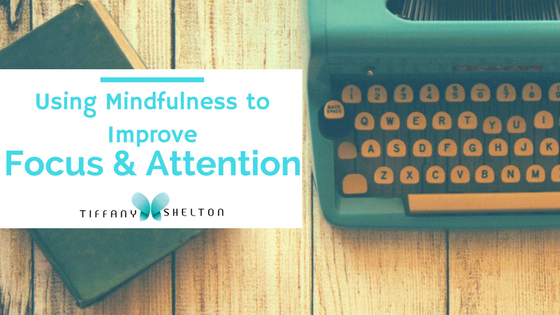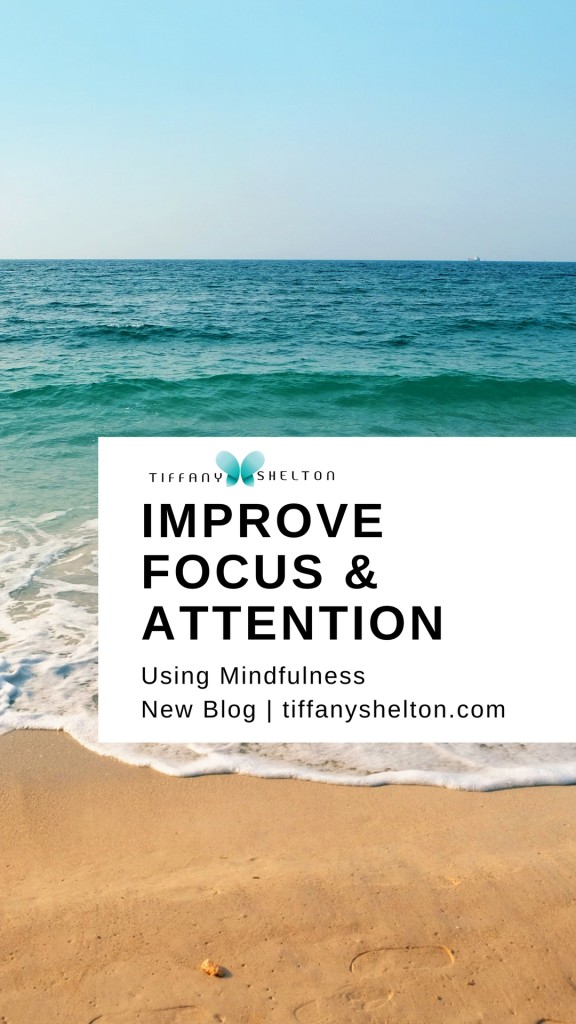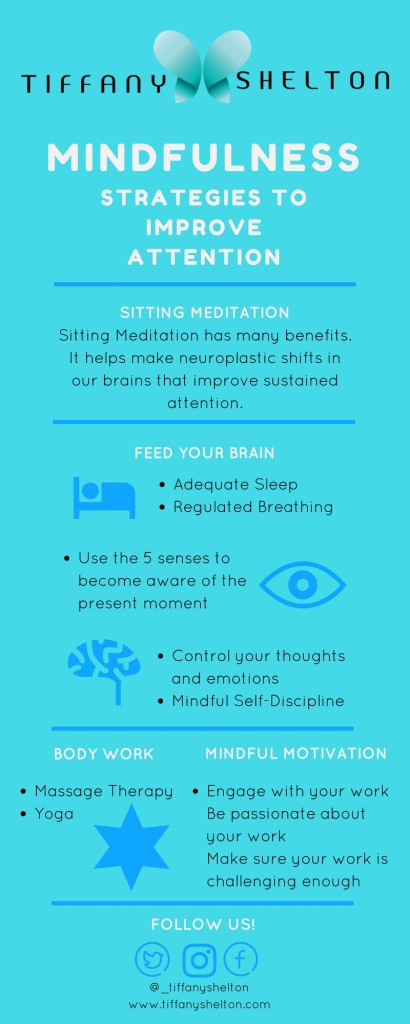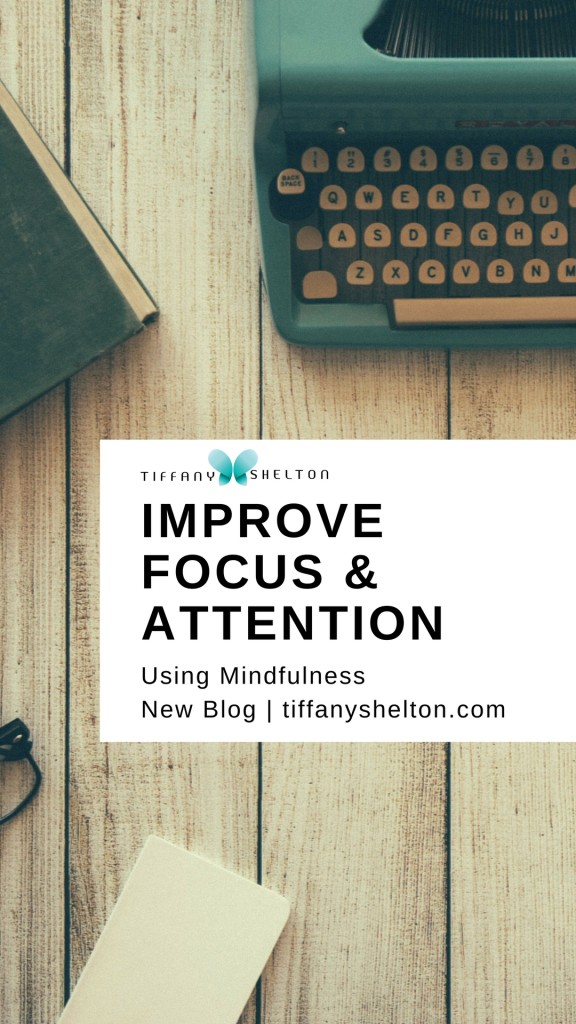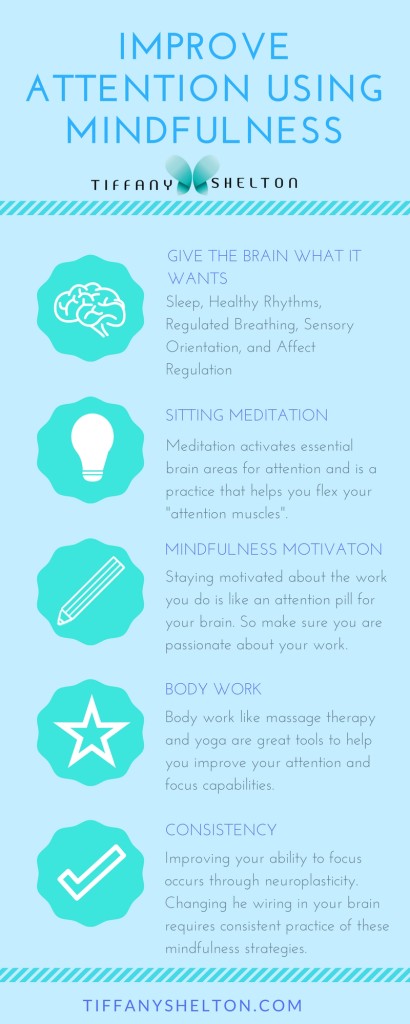Mindfulness Strategies to Improve Focus and Attention
Sign Up for my Conscious Lifestyle Newsletter for a Dose of Consciousness Straight to Your Inbox!
Click Here
*This blog shouldn’t serve as advice for the treatment of ADHD (Attention Deficit Hyperactivity Disorder), which is a mental health diagnosis that should be treated in person by a licensed professional. I recommend visiting a psychologist for testing and treatment recommendations if you think you may have ADHD.*
Learning to focus your attention can make the difference between your success and failure. Mindfulness can be the answer you are looking for.
We all know how distractions and lack of focus can ruin a work day. Being able to focus means you can get things done faster and more efficiently. And in the end, this means you will reach your goals much quicker!
Over the last decade, most of my work involved either studying, researching, or writing from home. So early on I had to teach myself how to focus, limit distractions, and meet deadlines. I remember when I first set out to master these skills. It felt like taming a wild beast.
So many days I found myself full of motivation, sitting down to my laptop ready to conquer my to-do list. However, to my disappointment I’d look up and realize that I’d lost significant time with distractions.
Whether it was the tangent google research search for a piece I was writing, or magically finding myself on Instagram screenshotting a yoga tip, my attention would run off like a wild animal. And when you’re working from home, there’s no one there to help you tame this animal. No bosses hovering over your back. No nosey coworkers snooping around your desk. Just you, your wildlike attention span, and a million distractions.
After one too many days of wasted time, and pushed deadlines, I decided I was gonna take control of my ability to pay attention. I will share some of what I did below, along with some brain science to help explain these tips. In the end, I slowly found a way to tame my mind with a conscious approach to focus and attention. There’s a time and place to let your mind run free, but you should be in control of when it does. Take control of your mind, and take control of your life.
But Wait, How Long Does this take?
Even if you have ADHD, there are things that you can do to optimize your personal ability to pay attention. Some of those adjustments, e.g. adequate sleep, will work immediately.
However, using mindfulness strategies and neuroplasticity to make overall increases in your abilities to pay attention takes practice over a longer period of time. Thinking of these tips as a mindfulness practice will be most helpful in creating lasting changes.
How Your Brain Pays Attention
According to researchers, attention has become a big interest of study within neuropsychology due to rising rates of ADHD and the increased use of technology (Cohen, 2014). Using the Posner (1994) model of attention, we can view attention in 3 parts:
- Alerting (The ability to stay vigilant or prepared)
- Orienting (the ability to focus on one thing, and shift to another if needed)
- Conflict Monitoring (Executive Attention; the ability to monitor distractions)
(Posner and Raichle 1994)
Correlated Brain Areas:
- Alerting – Reticular Activating System,
- Orienting – Parietal Lobe
- Conflict Monitoring – Anterior Cingulate Cortex; Frontal Lobe
(Modesto-Lowe, 2015)
You’ll find out how we will use this knowledge in a conscious approach to focus and attention.
What Does this Have to Do with Mindfulness?
Mindfulness encompassess activities that help bring the present moment into consciousness. Consciousness is a mental state of mind. It has many underpinnings and in many ways is controlled by what our minds allow in.
Mindfulness is a way to expand our consciousness, and attention is the first step in that process. If you can find more ways to: 1) experience mindfulness more often and 2) for longer periods of time, you will automatically start improving your ability to pay attention.
So How?
You can have a focused hustle that changes your work life for the better. If you are tired of wasting time with distractions, read these tips on improving attention mindfully.
ONE: SITTING MEDITATION
Sitting meditation is not just for relaxation. It helps make neuroplastic shifts in our brains that improve sustained attention. Many studies have touted the effects of meditation on increasing attention.
For Example:
- Improved focus (Jha, Krompinger & Baime, 2007) for long time meditators,
- Improved attention for new meditators (Tang et al., 2007),
- Increased attentional capacity for meditators (Slagter et al. 2007).
Focus author, Daniel Goleman, discusses how the basic move in meditation is flexing our attention muscle. We intentionally pay attention to an object of meditation such as our breath or our thoughts. Then, when we notice our attention drifting, we orientate ourselves and shift our attention back to the meditation object. This corresponds exactly to the components of attention described above (alerting, orienting, and conflict monitoring).
For example with insight meditation, you learn to constantly monitor your thoughts. The practice entails:
- paying attention to your thoughts,
- accepting it with curiosity and not judgement,
- letting it go.
Then you continue monitoring your thoughts until another one arises. And again you note it, and let it go. Without any fancy research, you can easily see how mastering this practice will help improve your attention skills.
Through neuroplasticity, meditation gives us the repetitive practice needed to rewire our brains to have more executive control over our attention.
I Can’t Emphasize This Enough
Be patient with this practice, rewiring the brain doesn’t happen overnight. But science is in favor of as little as 2 months of meditation practice to significantly improve your attention skills. So stick with it, and be consistent with your meditation practice. As you do so, you will see that your ability to focus will continue to grow.
That’s Not All
Also, make your mediation practice personal for faster results. Be very mindful of the shifts you make in your mind to become better focused. For example when you notice it takes you less and less time to get into a state of meditation, take note of why things got easier?
For me I noticed that I was able to get into meditation quicker, and stay focused longer during meditation when I properly set the scene before sitting down to meditate. This includes having my tea first, being in my sacred space, making sure I had my blanket and meditation journal, and feeling comfy and cozy. I realized I need this same preparation when I sit down to focus. Now I always set the scene in my work environment before I sit down to work, and it’s amazing how much better I focus. Other personal shifts might include letting go of expectations, or you might notice that doing a relaxation technique like a body scan first helps you to focus better during meditation. Whatever the personal shift, take note and apply it to your work life as well.
TWO: FEED YOUR BRAIN
Give your brain what it needs to focus in the moment. Usually paying attention is associated with the pre-frontal cortex because attention heavily relies on executive control. But there are also other important brain regions involved in attention that give us more insight into how attention works.
Using the Posner description of attention described above, attention consists of alerting, orienting, and conflict monitoring. According to much research, each of these components have been correlated with parts of the brain: Alerting has been correlated with the reticular activating system, orienting with the parietal lobe, and conflict monitoring with the anterior cingulate cortex (Modesto-Lowe, 2015). By tapping into increased functioning in each of these areas of the brain, we can in turn increase our attention capabilities.
Staying Alert
Give your brain what it needs to stay alert:
- Adequate sleep and natural rhythms
- Regulated Breathing
Alerting, which is the capacity to stay vigilant to what to pay attention to in your environment, is correlated with the part of the brain that is responsible for transitioning from sleep to wakefulness. It is housed in the brain stem, near the respiratory centers in the brain. This area is responsible for circadian rhythm (Audiffren, 2016). Knowing that neurons that wire together, fire together, we can begin to devise some key components of staying alert.
Here’s the deal
Namely, adequate rest and natural rhythms help keep us alert, but a case for regulating your breathing can also be made based on where the alerting structure is located in the brain. Healthy sleep habits and breathing exercises to help regulate the breath are hence very useful as you work towards improved attention.
Staying Oriented
Give your brain what it needs to stay oriented to the task at hand:
- Use the five senses to get in touch with the present moment
Orienting, the ability to focus on something and shift focus if need be, is located in the sensory area of the brain. Specifically, the parietal lobe receives and coordinates sensory information (Tuite & Konczak, 2010). Being oriented to taste, smell, sights, sounds, physical sensations, and vibrational energy helps to bring you into the present moment and therefore better able to focus on that moment. Before working, use your senses to orient yourself. And truly come in contact with the present moment while working.
In 2015, mindfulness guru Jon Kabat-Zin wrote an article called, “Why paying attention is so supremely important.” In this article, he discusses how our senses, including interoception, proprioception, and awareness, are the gateway to full attention. Describing raw perception of the present moment and pure attention, he writes, “ With our senses intact and by way of awareness itself, we can attend in such ways. To do so is to be more alive”
Here is a Sensory Exercise:
- Daniel Goleman, author of the book Focus, offers a free guided sensory exercise designed to help you increase your ability to focus. Click here to check it out
Manage Distractions
Give your brain what it needs to manage distractions:
- Control your thoughts and emotions
- Use mindful self-discipline to limit external distractions
Conflict monitoring, the final component of attention, is the ability to regulate your thoughts and emotions so that you can manage competing stimuli. This is housed in the anterior cingulate cortex (ACC), connected to our emotional limbic system which is responsible for fight or flight (Modesto-Lowe, 2015).
The ACC is also connected to the prefrontal cortex, the structure responsible for executive decisions in our brain. This combination makes this system the powerhouse of regulating our thoughts and emotions (Stevens et al., 1994). This system is heavily tied to avoiding suffering (fight or flight), something Buddhism discusses at lengths.
Affect Regulation
A powerful mindfulness tool to develop control over your emotions is the practice of acceptance. Acceptance calms our fight or flight response, and allows our brains to focus.
How Can You Actually Apply this?
Here’s how to practice acceptance when negative emotions are distracting you:
- See if you can accept the circumstance that is causing you fear, anger, or sadness.
- Can you accept the situation without trying to change it or wishing it was different?
- Ask yourself, “What was this situation sent here to teach me?”.
- Practice relaxation techniques to calm your body.
- Keep in mind that you are loved. Bring to mind loved ones that care about you.
- Remember that you have survived other hard situations.
- As you begin to accept the situation and relax, your fight or flight response will lessen. Then your brain will be better able to manage your emotions without letting them distract you from important tasks.
Also, avoiding suffering is not only involved in our fight or flight response, but it is also involved in our systems that seek pleasure. In his book, Buddha Brain, Dr. Rick Hanson describes how our archaic brain evolved to avoid sticks and seek carrots. Basically, when we have the luxury to not be avoiding suffering, we are seeking pleasure. This can come in the form of avoiding boring tasks and seeking out more pleasurable ones. This is how we find ourselves on Instagram while working. Your ability to regulate feelings like boredom, as you work are crucial to increasing your attention abilities.
Mindfulness of emotions is another great mindfulness strategy to use while working to increase emotional regulation skills.
- As you work, monitor how you feel emotionally each time you stray from work.
- Are you stressed, sad, bored, or even overwhelmed?
- In the moment see if you can notice these feelings.
- Accept them for what they are without letting them overcome you.
- Let them go if you are able to. .
Also-
Finding ways to process these emotions while you aren’t working is also beneficial and will lead to less distractions during work. Sometimes you may find that it is more beneficial, if you have the time, to stop what you working on and take a break to process how you feel. You’d be surprised how many times underlying emotions appear as attention deficits, when the real underlying issue is emotional control. In my training to become a neuropsychologist, I have seen many people that think they have ADHD but when we test them we find out that it is actually emotional issues like depression and anxiety impairing their ability to pay attention.
Cognitive Control
Do constant thoughts and ideas distract you while working? Click here to read my blog on effective thought stopping strategies.
Apps to help you limit external distractions
Many times we lose focus because our minds are seeking a dopamine rush, and things like distracting social media are the perfect fix. Here are some resources to help you limit those external distractors:
- Block distracting websites – Hey Focus!
- Stop being distracted by your phone – Freedom
- Become more aware of where you spend your time on the internet – Rescue Time
That’s Not All
Also, read my blog “6 Ways to Develop Self- Discipline” for more tips on developing the self-discipline needed to manage distractions.
THREE: BODY WORK
If you want a more active way to flex your attention muscle, try using body work to improve your focus skills. Here are my two favorite ways to do this.
Massage
Through consistent body work with a massage therapist, I learned how to tolerate distractions. My massage therapist is highly qualified and takes her work very seriously. At the beginning of our relationship she made it very clear that we would be working together to heal my body and my mind. This was not going to be a one-sided relationship.
My first task in our work together was to learn to manage my hyperactivity. I had a lot of tension and restlessness in my body, and when we first started working together, it was very hard for me to stay still. My body would endlessly fidget and my mind jumped from one bodily sensation to another. These sensations felt like they were commanding me to scratch or move in an effort to become perfectly comfortable.
Why Does this Matter?
Hyperactivity of the mind or body usually accompanies attention problems, and learning to manage this restlessness helped me develop tools to focus my mind and tolerate distractions. Each massage I practiced tolerating distracting sensations. I became comfortable with stillness and learned it was very different than perfect comfort. I learned to focus my mind on the sensation of the massage and whenever I was distracted or tempted to move, I began to do the following:
- Notice the distracting sensation.
- Acknowledge that while it was uncomfortable, it wasn’t painful and therefore I could tolerate it.
- Use breathing techniques to work through the tickle, itch, or desire to move.
- Focus my attention on the massage sensation I was feeling at the moment, and really used all my senses to become completely aware of that body part.
- This includes mindful awareness of the tension/resistance at the massage cite, as well as visualization of the body part being massaged.
Yoga
Yoga is also another great body work technique to improve your attention. The practice of yoga gives us an opportunity to practice focusing in a safe and non-judgmental way. Here are some ways you can use yoga to improve your attention:
- Maintain Ujjayi breath throughout the practice. Whenever you notice that you have lost your Ujjayi breathing, without judgement, simply practice returning to the breathing technique.
- Pay attention to how you flow throughout the class. This is another great way to flex your attention muscle. Try to maintain an elegant, and poised flow in your next yoga session. Trust me, you will find times when you are extra sloppy or even careless. No worries, that is part of the practice. Simply congratulate yourself for the ability to notice you let go of your flow, and simply go back to flowing.
- Pay attention to sensations in your body during practice. This is inherent in most our yoga practices. But I encourage you to really increase your awareness of every physical sensation to increase your focus. Choose at least 1 day of the week that you practice yoga, and dedicate that practice to mindful and intentional movement of every pose.
FOUR: MINDFUL MOTIVATION
I couldn’t write a blog about staying focused as a go-getter, without talking to the most focused go-getter I know: my partner, Jean Victor Mariolle. And I’m not just saying that because he’s cute. Jean-Victor (or JV as I call him!), is the VP of Business Development for a thriving natural food company. Before VP life he had extensive sales experience, and oversaw the worldwide expansion of a leading brand. I’ve never met someone more focused than he is when he works.
Contrary to his attention abilities outside of work, he has an amazing ability to resist distractions and stay focused while working. So I asked him, “What’s the secret to your impeccable ability to stay focused while working?”. His answer:
“I have to say, … motivation. I love what I do. I’m passionate and excited about our opportunities. And the work I do is so engaging that distractions become obsolete.”
Based on neuropsychology, this makes a lot of sense. Even people with ADHD, have increased abilities to pay attention on activities they are passionate about, challenging, or fun. In fact, they typically perform better trying to pay attention to complex or challenging tasks versus simple ones. This is because dopamine (pleasure neurotransmitter), is released when we experience passion, which helps the brain focus better.
Bottom Line …
- Engage with your work
- Be passionate about your work
- And Make sure your work is challenging
Find out more mindful motivation in my recent blogs:
Motivation: The power of meaning and purpose
Staying Motivated: Unlocking your Third Chakra Power
Attention and focus are essential to any conscious hustle. Use these mindfulness tips to improve your attention span and reach your goals faster.
Success is your destiny, you just have to make sure you develop the skills you need to reach it. Here is an infographic summary of all the tips:
Let me know what you think of these mindfulness strategies to improve attention and focus!
Sign Up for my Conscious Lifestyle Newsletter for a Dose of Consciousness Straight to Your Inbox!
Click Here
– Tiffany Shelton, M.A. is a conscious lifestyle blogger and training to become a neuropsychologist in Los Angeles, CA. Her passion to elevate consciousness incorporates brain science, psychology, and spiritual philosophies. Her writing goes beyond the message of self-care or wellness, but instead consciously adds to these movements by demanding awakening and insight. Learn more about Tiffany Shelton by clicking here.
References
Audiffren, M. (n.d.). Reticular activating system. Retrieved August 06, 2017, from http://www.sciencedirect.com/topics/neuroscience/reticular-activating-system
Cohen, Ronald A.; Publisher: Springer Science + Business Media; 2014. xxvii, 978 pp
Posner, M. I. (1994). Attention: the mechanisms of consciousness. Proceedings of the National Academy of Science, 91, 7398– 7403.
Modesto-Lowe, V. (2015). Does mindfulness meditation improve attention in attention deficit hyperactivity disorder? World Journal of Psychiatry,5(4), 397. doi:10.5498/wjp.v5.i4.397
Posner, M. I., & Raichle, M. E. (1994). Images of mind. New York: Scientific American Library.
Slagter, H. A., Lutz, A., Greischar, L. L., Francis, A. D., Nieuwenhuis, S., Davis, J. M., & Davidson, R. J. (2007). Mental Training Affects Distribution of Limited Brain Resources. PLoS Biology, 5(6). doi:10.1371/journa
Stevens, F., Hurley, R., & Taber, K. (2011). Anterior Cingulate Cortex: Unique Role in Cognition and Emotion. The Journal of Neuropsychiatry and Clinical Neurosciencies, 23(2), 121-125.
Tuite, P. J., & Konczak, J. (n.d.). Parietal lobe. Retrieved August 06, 2017, from http://www.sciencedirect.com/topics/neuroscience/parietal-lobe
Kabat-Zinn, J. (2015). Why Paying Attention is so Supremely Important. Mindfulness, 6(6), 1484-1486. doi:10.1007/s12671-015-0455-y
Mindfulness Strategies to Improve Focus and Attention

